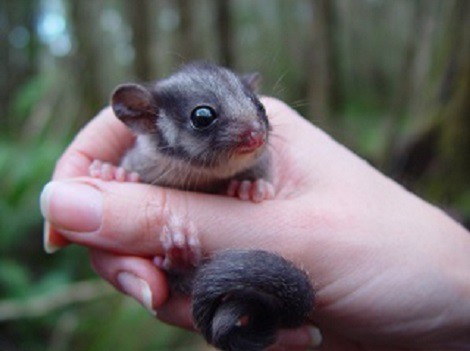Leadbeater’s Possums – VCE Enviro Science Unit 3
-
Forest
-
Human Impacts
-
Possums
-
Enviro Science
-
Conservation



Excursion Program Overview
It is believed that Leadbeater’s Possum evolved about 20 million years ago. Historical records and fossil distribution suggest they once colonised a large area of the Great Dividing Range from north of Melbourne to south of Sydney. There are estimated to be between 1,000 and 2,000 only Leadbeater Possums left in highland populations.
The Leadbeater’s Possum, which is Victoria’s faunal emblem, is the only marsupial endemic to Victoria.
It is a small omnivorous arboreal marsupial. The species was discovered in 1867, then thought to be extinct from 1909-1960, until it was rediscovered in 1961. The possum was sighted by naturalist and geology student Eric Wilkinson near Marysville, at Cambarville, 90 to 120 minutes north-east of Melbourne – far from its original known habitat in the swamp forests of Western Gippsland around the Bass River region towards Western Port Bay and Phillip Island.
Currently, the Leadbeater’s Possum is listed as Critically Endangered under the Environment Protection and Biodiversity Conservation Act 1999. The remaining populations of Leadbeater’s Possum are in danger of extinction due to natural collapse of large, old hollow-bearing trees.
During this fieldtrip you will:
- Explore the requirements that Leadbeater’s Possum have for survival.
- Investigate past and current management strategies to conserve Leadbeater’s Possum populations.
- Discuss the impact of the Supreme Court orders that were handed down in November 2022 that limited the area available for logging and expanded protected areas after it found the state-owned logging agency VicForests failed to adequately protect the yellow-bellied glider and the endangered greater glider in Victoria which then moved forward a ban on native timber harvesting in state forests from 2030 to January 1, 2024.During this 4 hour program, you will visit the majestic mountain ash forests of Toolangi, exploring the intricate ecosystems found in the Victorian Central Highlands and a clear felled logging coupe. You will discuss present management of the forests and how this affects overall biodiversity and that of the survival of the Leadbeater’s Possum and the changes made to logging to protect them. Students will make observations and have the option of collecting data to be used for the Outcome’s Assessment task in relation to the management of this threatened endemic species.
- Visit Leadbeater’s Possum habitat, Mountain Ash forest with old growth tree and a Logging Coupe
Inclusions and Notes
Equipment supplied by Gould League: Safety helmets worn by all participants; workbooks and all tools required for fieldwork data collection.
Equipment needed: A chartered bus (which is required to remain with the group at all times). First aid kit, sun screen, insect repellent and PPE including hand sanitiser to kill viruses, bacteria and other micro organisations.
Please note that our Gould League educators will travel on your bus for the duration of your program time. We ask schools to ensure when booking coaches that 1 one seat is allocated for each group booked as they will provide commentary on the bus to students and guide the bus drivers. Please advise the Bookings Manager if there is no room on the coach for our educators, and travel fee of $0.88 per km will be added to your final invoice. This amount will vary according to the activities undertaken on the day which can vary due to local weather conditions. Maximum travel fee is $40. This covers the cost of one vehicle only as Gould League Educators will carpool.
Student needs to bring: Their own water and lunch, sunscreen, a clipboard, pencil, and a copy of the Gould League workbook (usually sent 14 days prior to excursion so copies can be made for students) to guide the program, bag to take away your rubbish.
Restrictions: This Gould League program is delivered in the Toolangi State Forest, in the North Central Fire District and does not operate on days with a Fire danger rating of Extreme and Catastrophic. On rare occasions, programs may be postponed due to extreme weather predictions involving wind/storms. In both cases, these programs will be rescheduled at the earliest convenience of both parties.
Programs however DO operate during wet/snowy weather. Please contact us to discuss the best timing to optimize your group’s experience and ensure suitable clothing and footwear for the conditions predicted. Plan for wet weather from April-October, and expect temperatures at least 5 degrees colder than suburban Melbourne.
Curriculum Links
Key Knowledge for AOS 1 Outcome 1
Importance of biodiversity
- Ecosystems as a source of renewable services that impact on human well-being including provisioning services (food, water, pharmaceuticals), regulating services (carbon sequestration, climate control), and supporting services (soil formation, nutrient and water recycling, air and water purification
Biodiversity change over time - The impact of humans on the present rate of species extinction
- The isolation of populations over short (volcanic eruptions or fire), medium (El Nino) and long (tectonic plate movement and evolution) time scales that can produce different species that are unable to interbreed, are endemic to a location, form a diversity hotspot, or become extinct.
Measuring changes in biodiversity - Sampling methods used for assessing species diversity including grids, transects, different shaped quadrats (including consideration of edge effects), and mark-recapture
- Conservation classification of species and how this depends on measures including changes in the geographic range and number of individuals within that range, the date the species was last recorded, and the extent of habitat.
Threats to biodiversity
- Predictions of species population survival using probabilities including likelihood of extinction
- Human and non-human threats to biodiversity including: creation and isolation of small populations through habitat modification and over-exploitation; genetic swamping, inbreeding, and demographic variation due to small population size; loss of pollinators, dispersal agents, host species or symbionts that affect reproduction and persistence of species; and exotic species that compete for habitat, shelter and food
- Assessment of threat in defining conservation categories for a species and/or ecosystem, including extinct in the wild, conservation dependent, critically endangered, endangered, and vulnerable.
Protection and restoration of biodiversity
- Strategies for maintaining and growing populations that also build species resilience to changes in the environment, including: protected areas; retaining remnant vegetation; wildlife corridors or zones; translocation of animals; habitat regeneration, restoration or replacement; captive breeding and reintroduction programs; gene banks for the collection of specimens and genetic material; and reduction and improved targeting of pesticides in agricultural and urbanised areas
- The application of relevant international, national, state and local legal treaties, agreements and regulatory frameworks that apply to the protection of threatened species including the Convention on International Trade in Endangered Species (CITES), IUCN Red List of Threatened Species, World Heritage areas, Environment Protection and Biodiversity Conservation Act 1999 (Australia), Victorian Flora and Fauna Guarantee Act, and local government conservation covenants
- Sustainability principles relevant to biodiversity conservation including: inter- and intra-generational equity including funding of selected species; the precautionary principle in relation to habitat change or introduction of species; ethical principles for managing biodiversity including justice and beneficence; and value systems including anthropocentrism, biocentrism and ecocentrism.
VCE Study Design extracts reproduced by permission, © VCAA. VCE is a registered trademark of the VCAA. The VCAA does not endorse or make any warranties regarding this study resource. Current VCE Study Designs, past exams and related content can be accessed directly at www.vcaa.vic.edu.au
